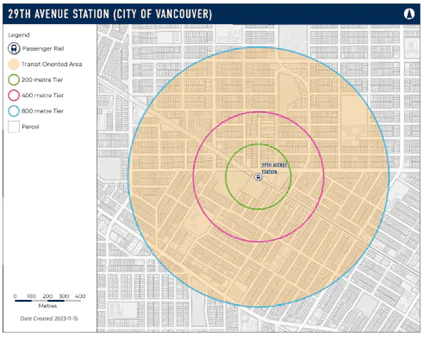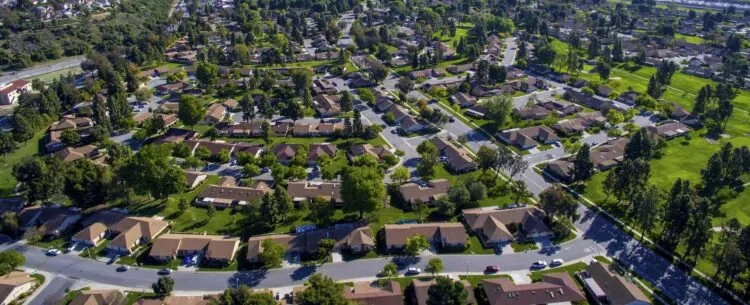Update: December 7 was a big day for the Housing Statutes (Transit-Oriented Areas) Amendment Act, 2023 in B.C.

Authors: Jennifer Williams and Anna Schlagintweit
On December 7, 2023, British Columbia passed a number of Orders in Council regarding the Housing Statutes (Transit-Oriented Areas) Amendment Act, 2023, S.B.C. 2023, c. 48 (the “Act”).
The Orders in Council bring into force sections of the Act, which aim to promote higher density and reduce parking requirements near transit stations, and introduce regulations that define transit-oriented areas, designate transit stations and prescribe minimum permitted densities and heights for different land tiers.
Below is a summary of the Orders in Council passed on December 7, 2023:
Order in Council No. 674 (“OIC 674”)
OIC 674 brings into force Sections 1 to 7, 9, 11, 23 and 24 of the Act effective December 7, 2023, thereby amending the Local Government Act.
For a summary of the legislative changes to be implemented by the Act, please see our previous blog post and update regarding Bill 47-2023.
OIC 674 also enacts the Local Government Transit-Oriented Areas Regulation (the “LGTOA Regulation”), which provides that transit-oriented areas include (i) the areas within 400 metres of a transit station that is a bus stop, bus exchange or West Coast Express station, and (ii) the areas within 800 metres of a transit station that is a passenger rail station, other than a West Coast Express station.
The schedule to the LGTOA Regulation lists the bus exchanges, passenger rail stations and West Coast Express stations that are included in the definition of a “transit station” under the Act. The LGTOA Regulation designates 36 transit stations. The majority of the transit stations are current Skytrain or Canada Line stations or planned stations for the Surrey Langley SkyTrain. At this time, no bus stops have been designated as transit stations under the Act.
The LGTOA Regulation also prescribes five tiers of land. These tiers are established based on the proximity of the land to a transit station. Tiers 1, 2 and 3 concern lands located within 800 metres of a passenger rail station that is not a West Coast Express station. Tiers 4 and 5 concern land that is located within 400 metres of a bus stop, bus exchange or West Coast Express station.
Finally, the LGTOA Regulation includes tables that set out the minimum permitted densities and heights for each land tier. The permitted densities and heights within each tier vary across municipalities; however, generally speaking, greater heights and densities are permitted closer to transit stations, while lower densities and heights are permitted further away from transit stations within transit-oriented areas.
Order in Council No. 676 (“OIC 676”)
OIC 676 brings into force Sections 12 to 17, 20 and 22 of the Act effective December 7, 2023, thereby amending the Vancouver Charter.
For a summary of the legislative changes to be implemented by the Act, please see our previous blog post and update regarding Bill 47-2023.
OIC 676 also enacts the Vancouver Transit-Oriented Areas Regulation (the “VTOA Regulation”). The VTOA Regulation is generally consistent with the LGTOA Regulation, except all of the bus exchanges, passenger rail stations and West Coast Express stations designated as transit stations under the VTOA Regulation are located in Vancouver. The transit stations designated under the VTOA Regulation include current and planned passenger rail stations along the SkyTrain, Canada Line and Broadway Subway routes.
Both the LGTOA Regulation and the VTOA Regulation provide that by June 30, 2024, a local government must not require an owner or occupier of any land or building in a transit-oriented area to provide off-street parking spaces for residential use, other than those for use by disabled persons.
Order in Council No. 677 (“OIC 677”)
OIC 677 enacts the Designation of Transit-Oriented Areas Regulation (the “DTOA Regulation”) effective December 7, 2023. The DTOA Regulation designates 43 interim transit-oriented areas under the Local Government Act and 20 transit-oriented areas under the Vancouver Charter.
The provincial government has designated interim transit-oriented areas for the City of Vancouver and local governments which have existing Official Community Plans or Official Development Plans that contain a commitment to supporting transit-oriented development.
Below is an example of how a transit-oriented area is shown in the DTOA Regulation (see page 6 of the DTOA Regulation):

Order in Council No. 678 (“OIC 678”)
OIC 678 brings into force Sections 8, 10, 19 and 21 of the Act effective June 30, 2024, which require local governments and the City of Vancouver to designate the transit-oriented areas for the transit stations within their respective jurisdictions by June 30, 2024.
Effective June 30, 2024, OIC 678 also amends the LGTOA Regulation and the VTOA Regulation to include a number of additional designated transit stations under the Local Government Act and the Vancouver Charter.
Designations of transit-oriented areas by local governments and the City of Vancouver must include any land designated by the province and, in making such designations, local governments and the City of Vancouver must take into consideration the applicable guidelines published by the Province under the Local Government Act or the Vancouver Charter. This includes the Provincial Policy Manual: Transit Oriented Areas (December 2023), discussed below.
Provincial Policy Manual: Transit Oriented Areas (the “Policy Manual”)
In December 2023, the provincial government released the Policy Manual as an interpretive aid for local governments and the City of Vancouver to help them navigate the implications of the Act.
The Policy Manual may also serve as a helpful resource for developers and property owners seeking to understand how these changes in the law may affect them. For example, the Policy Manual includes guidance regarding the minimum density requirements at pages 10-15 and page 31, and regarding the connection between Official Community Plans and Zoning Bylaws at pages 18-19.
British Columbia has also created this webpage as a resource for those seeking more information about the amendments resulting from the Act.
The Act is not a catch-all solution
It is important to note that the Act does not change the rezoning process of a local government. Processes and requirements, such as application fees, submission requirements and bylaw adoption, are not affected by the Act or the regulations. Additionally, development permit applications and building permits will still be required.
Also, the requirements and restrictions in the Act do not apply for any in-stream zoning bylaws amendments that have received first reading by their respective local government before December 7, 2023.
The Act also does not apply to lands which fall outside of a local government’s jurisdiction. For example, a transit-oriented area cannot be designated over lands which fall within the Agricultural Land Reserve since this is outside of a local government’s jurisdiction.
The amendments to the Local Government Act and the Vancouver Charter to be implemented as a result of the Orders in Council passed on December 7, 2023 will likely result in significant changes to the residential real estate development landscape in B.C.
If you have questions about what these changes could mean for you, or would like assistance with navigating the new legal framework, contact the authors to connect with a member of our British Columbia real estate practice group. Our experienced team can help you better understand these legislative changes and help you make the most of your development.
MLT Aikins’s real estate practice group is here to assist with all real estate and development matters, including matters involving real estate litigation.
Note: This article is of a general nature only and is not exhaustive of all possible regulatory requirements, legal rights, or remedies. Laws may change over time and should be interpreted only in the context of particular circumstances. These materials are not intended to be relied upon or taken as legal advice or opinion. Readers should consult a legal professional for specific advice in any particular situation.



